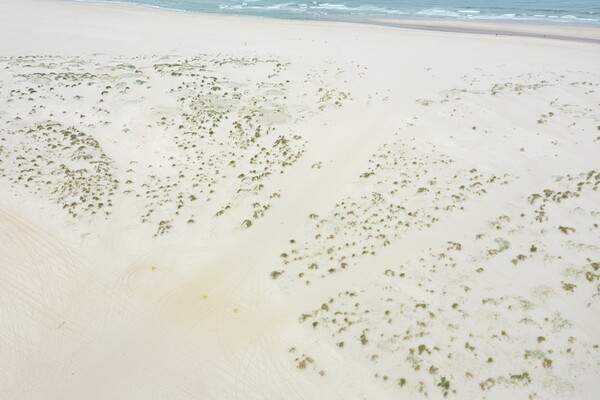S.J. van Rosmalen1*, J-M. Homberger1, M.J.P.M. Riksen1, J. Limpens1
1Wageningen University and Research, the Netherlands
*sasja.vanrosmalen@wur.nl
Introduction
Sandy shores provide multiple services: they protect the inland from flooding, support a high biodiversity, and are recreation hotspots (Everard, Jones, and Watts 2010). Not all services can co-exist, however. For example, recreation reduces species abundance and diversity by adding an additional stressor to the system (van Rosmalen, et al. in prep). Research found that directing visitor movements via boardwalks enables better co-existence of dune vegetation and recreation (Prisco et al. 2021). We investigated the effect of recreational pressure on the establishment of two common dune-building species Marram grass (Ammophila arenaria) and Sand-couch grass (Elytrigia juncea) in an area with existing pathways.
Objective and Methods
We conducted a field experiment at the mega nourishment the “Zandmotor” near The Hague, The Netherlands. We introduced both dune-building species by means of seeds and rhizomes at different distances to existing pathways. We used a randomised block design with 4 factorial treatments (species * diaspore type) and 30 replicates. Local genetic plant material was collected and introduced into plots of 50x50cm. The plant seeds were left in their husk to mimic natural dispersal. The position of each plot was recorded by means of Real-Time Kinematic positioning after which the plots were left unmarked to avoid influencing people's behaviour. Recreation pressure was assessed by counting visitors 5 times for 15 min at different sections of the research area across two days in July 2022. Establishment success was monitored by counting the number of emerged shoots from seeds and rhizomes per plot across the growing season of 2022. To control for other drivers, we also monitored environmental variables, such as the change in surface level.
Results
Our observations show that most visitors use the stable main pathways to move through the area. Preliminary results on the establishment success revealed that the negative effect of recreation is more localised compared to beaches without pathways. This suggest that creating landscape designs with clear path structures can promote the co-existence of plant biodiversity and recreation in embryo dune fields.

Figure 1: Research area on the Zandmotor with visible main pathways.
References
Everard, M., Jones, L., & Watts, B. 2010. “Have We Neglected the Societal Importance of Sand Dunes? An Ecosystem Services Perspective.” Aquatic Conservation: Marine and Freshwater Ecosystems 20 (4): 476–87. https://doi.org/10.1002/aqc.1114.
van Rosmalen, S. J., Homberger, J., Riksen, M.J.P.M., & Limpens, J. 2024. “Recreation impact on the early establishment of dune building grasses Elytrigia juncea and Ammophila arenaria on the beach.” [Manuscript in preparation].
Prisco, I., Acosta, A.T.R., Stanisci, A. 2021. “A bridge between tourism and nature conservation: boardwalks effects on coastal dune vegetation.” Journal of Coastal Conservation 25 (14). https://doi.org/10.1007/s11852-021-00809-4


